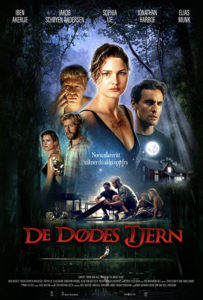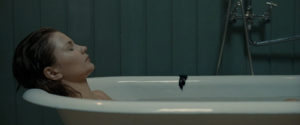Film Review: “Lake of Death” Displays a Visually Promising Premise, Only to Mix and Confuse with Repetitive Horror Conventions
Written by: Adam Vaughn | July 20th, 2020

Lake of Death (“De dødes tjern”) (Nini Bull Robsahm, 2019) 2 out of 4 stars.
One of the hardest things for the horror genre nowadays is to reflect on what content has been made previously and determine what is going to be newly fresh and bold to an audience. In the case of Lake of Death, director Nini Bull Robsahm (Amnesia) demonstrates a passionate use of abstract and chilling cinematic and editing techniques, yet confusingly mixes conventional horror elements, some to add comedic relief, some to continue to push the ostensibly scary tone of the film. By themselves, these two conventions would have created two entirely different tones for the film; however, by combining them, Robsahm can’t quite make up his mind whether he wants to tell a deeper story, jump-scare the audience thoroughly throughout the film, or leave the audience with a chilling visual imprint. Unfortunately, Lake of Death attempts to do it all at once, and the result is a scattered set of themes and tone that distract from the meticulous storytelling.
The film tells the tale of Lillian (Iben Akerlie, Going West), who journeys with her friends out to a remote lake house where her brother, Bjorn (Patrick Walshe McBride), went missing a year earlier. As Lillian is tormented by frightening images of terror that only she can see (maybe?), the group encounters strange occurrences that force them to question whether they are alone at the secluded lake house, and more importantly, if something, or someone, is out to get them. Robsahm immediately begins the film with a sense of serenity, a route seldom taken in the horror genre, and a moment I believe works to her benefit to establish an intimacy between Lillian and Bjorn.
As we venture further into the film, however, the viewers are met with jump scare after jump scare, to the point of overuse and to the dismay of the viewer attempting to follow the story, distracting from the plot. Lillian’s visions leading up to the final encounter, while foregrounding the horror elements of the story and frightening the audience in an aesthetically effective way, become hard to put together by the end of the film. Robsahm challenges the viewer to determine whether Lillian’s visions are metaphysical and in her mind, or if a supernatural presence looms amongst the group of friends. This determination, however, cannot be made by the end of the film, as the various plot points contradict each other, and the elements of horror are left open-ended by the conclusion.

Lake of Death deserves a considerable amount of praise for its effective avoidance of graphic, gruesome terror in the telling of a scary story, yet by the end of the film, as the viewer throughout has pondered who the antagonist will eventually be, the result ends up being underwhelming and leaves us with more frustrated questions than thought-provoking ones. Our cinematic journey too often wavers in mood and comes across as trying too hard to add horror conventions to an otherwise abstract and expressionist addition to the horror genre.
[In Norwegian, with English subtitles.]

